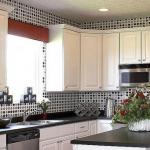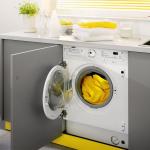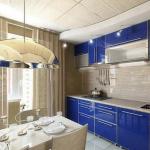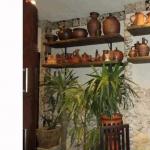Let's try to figure out which wallpaper will be best for the kitchen, as well as understand what you need to focus on when purchasing wallpaper for the kitchen. In a room such as a kitchen, high humidity always predominates, the temperature changes periodically, and there is also a high risk of dirt and grease getting on the wallpaper.
Selection of wallpaper for walls
In order to understand which wallpaper is better to glue in the kitchen, it is necessary to clarify the basic properties that they should have. So, for the kitchen, such wallpapers are suitable that have increased resistance to moisture, high density, resistance to ultraviolet radiation, vapor permeability, resistance to detergents, and the possibility of repeated staining.


An equally important attribute is the vapor permeability of the wallpaper that will be used to paste over the walls in the kitchen. Finishing materials that will be used to decorate the walls in the kitchen should dry out in a short time. Otherwise, mold, fungus, microorganisms harmful to the human body may appear on the walls of the kitchen.

Re-staining is typical for those wallpapers that are intended for painting. Responsible manufacturers of finishing materials for walls in the kitchen are trying to produce products that can withstand up to 10 repeated stains.

High-quality vinyl canvases consist of a non-woven or paper base, on which a layer of vinyl is applied. Gluing such finishing materials is a simple task, since the roll will not be deformed on the wall.

Foamed vinyl has a significant relief, perfectly breathable. But with constant wet cleaning, such materials will quickly lose their aesthetic appearance, so they can hardly be called the best option for pasting a kitchen.

The photo shows the finished version of pasting the walls of the kitchen with vinyl wallpaper.
Well-known manufacturers monitor their business reputation, so their products are distinguished by all sanitary and environmental standards.
Interlining
Non-woven fabrics are made from pressed cellulose fiber. Interlining has increased mechanical strength, it does not swell from moisture, does not lose its aesthetic characteristics during operation. Even beginners can cope with such canvases, you just need to stock up on special glue designed for pasting walls with non-woven materials.

What are the advantages of this type of wallpaper? When sticking them on the walls, there is no need to apply glue to the walls, it is enough to smear only the tapestries themselves with it.

Not all vinyl materials are able to "endure" systematic wet cleaning, which involves the use of brushes, various powders, and other abrasive products. Also among the few shortcomings of these finishing materials, their high cost should be mentioned.
Fiberglass
Fiberglass, which has recently gained its popularity, has a long service life. This material is characterized by a fabric base, which has a fiberglass impregnation. The strength of fiberglass exceeds vinyl wallpaper by 3-5 times.





